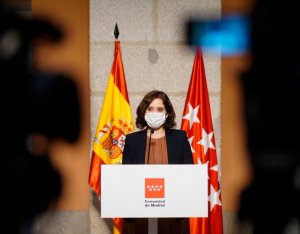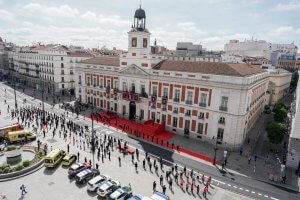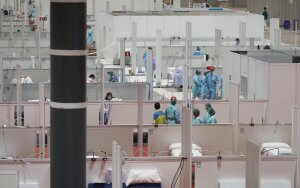Latest: Coronavirus in Spain figures (20 Oct)
As the Madrid region imposed partial lockdown measures on nearly one million citizens on Friday, in a further attempt to stop the spread of Coronavirus (Covid-19), the regional government led by Isabel Díaz Ayuso is now under the spotlight for its handling of the health crisis.
Overall, Spain has recorded 125,944 new infections of Coronavirus in the past 14 days – with 36% of them in Madrid. Figures released by the Health Ministry on Friday showed that Madrid has seen 45,482 infections in 14 days – a total of 187,045 since the start of the pandemic. The number of cases per 100,000 people for Spain overall in the past 14 days is 267.82. For Madrid that figure is 682.57. There have been a total of 8,999 Coronavirus-related deaths in the region – 144 in the past 7 days.
Announcing new restrictions in 37 healthcare zones of the region [see list below], including in the capital itself – areas that are home to 858,000 people, or 13% of the region’s 6.6m population – Díaz Ayuso told a press conference on Friday that, ‘we are obliged to take these measures in these specific areas … if we did not do so, we run the risk of it being spread to the whole of Madrid. We have time to avoid it.’
Residents of these 37 areas [see list below], mainly densely populated, low-income neighbourhoods in the south of Madrid, will only be allowed to leave their zone to go to work, seek medical care or take their children to school from Monday – for at least 14 days.
All bars and restaurants in these areas will also have to reduce their capacity to 50%. Residents of the areas affected will be allowed to move around freely inside their zone but no-one from outside will be allowed in. Social gatherings of more than 6 people will be banned in the entire region, down from 10 currently, as part of the new measures.
On Friday Díaz Ayuso also promised that Madrid would be carrying out ‘one million tests to all the residents of the areas with the most Covid-19 infections’.

Since Spain entered its New Normality phase on 22 June after the central government ended the ‘state of alarm’ that had been in place from 14 March, responsibility for public healthcare and managing the Coronavirus pandemic has been left in the hands of Spain’s 17 regional governments.
The Spanish government, led by prime minister Pedro Sánchez, is a coalition between the socialist PSOE party and the left-wing Podemos group. The Madrid regional government is a coalition between the right-wing People’s Party (PP) and the centre-right Ciudadanos (Cs) party, with support from Spain’s far-right Vox party.
ALSO READ (6/9/20): Sánchez seeks ‘unity’ for Spain’s recovery plan, yet PP refuse alongside ‘radicals’
During the central government’s four phased plan to relax the country’s lockdown restrictions, the Madrid regional government under Díaz Ayuso criticised the prolonged ‘state of alarm’ and lockdown measures – and even threatened legal action when Madrid was not allowed to relax certain restrictions and move from one phase to another.
During the phased lifting of lockdown restrictions in May-June, the Madrid region had requested to move to Phase One from Phase Zero on two occasions – from 11 May and then also from 18 May, but permission was not granted by Spain’s central Health Ministry. At the time, the Madrid regional government filed an appeal with Spain’s Supreme Court to investigate why the Health Ministry twice denied their request, claiming it to be a ‘political issue’. Both Madrid and Barcelona remained in a sort of ‘Phase 0.5’, with Madrid finally moving to Phase One from 25 May.
Back in May, while questioning the prolonged ‘state of alarm’, Díaz Ayuso had said that ‘people get run over every day but that doesn’t mean we ban cars’. She tweeted on 15 May that, ‘There was no technical explanation [for why Madrid was being kept in Phase Zero]. We are not the region with the highest % contagion. We are prepared. Our businesses are ruined and each week we lose around 18,000 jobs. Madrid has fulfilled.’

Also at the time, the Madrid regional government’s vice-president, Ignacio Aguado of the Cs party, tweeted that, ‘The decision of the Government of Spain has not been technical, but political. They have not presented a single argument that justifies that we cannot pass the phase. We complied and they opposed it. They are condemning thousands of Madrid residents to ruin and destroying Spain’s economic engine.’
More recently during the New Normality, prime minister Sánchez announced on 25 August that the regional governments of Spain could also request ‘regional states of alarm’ if required to combat the virus. But while many regions in Spain have applied further restrictions, particularly focused on nightlife and social gatherings, not one region has asked for a state of alarm.
On Thursday, prime minister Sánchez wrote to Díaz Ayuso, seeking a meeting to discuss the situation of Coronavirus in the region. Díaz Ayuso agreed to the meeting and it is to take place on Monday 21 September at noon. She tweeted on the same day that Madrid ‘has been alone for too long’ and that she was pleased that the Spanish prime minister ‘had finally agreed to meet with her’.
Díaz Ayuso had earlier come under criticism for claiming in the week that the infection rate in the south of Madrid was due ‘among other things, to the way of life of immigrants in Madrid and the population density in these districts’.
The letter from Sánchez seeking a meeting followed on from Madrid’s regional vice-president Ignacio Aguado calling on the Spanish government to ‘actively get involved’ with helping to combat the spread of Coronavirus across the region.

In a press conference last Thursday, Aguado had said that ‘the situation of the epidemic in Madrid is not going well. It is getting worse. We are going to have to make greater efforts’.
Earlier during the week, health authorities in Madrid had warned that new restrictions on movement to slow the spread of the virus, would come into effect either on Saturday or Monday – but it later caused confusion when it was subsequently denied by the regional government, reportedly to avoid the word ‘lockdown’.
Regional health chief Antonio Ruiz Escudero had said the Madrid government was working on a series of measures ‘to restrict mobility and reduce activity in certain areas .. where the virus is most-widely transmitted’.
Commenting on the recent Coronavirus figures released, the Spanish Health Minister Salvador Illa said, ‘We have to do whatever is necessary to control the situation in Madrid’ where we have ‘what is likely the biggest problem’.
The areas affected in Madrid
The new measures in 37 areas of Madrid come into force from Monday 21 September, and will be in place for at least 14 days.
The areas affected are 26 healthcare zones (in 6 districts of the city) and 11 further areas (in 8 municipalities). The areas are as follows:
In the city of Madrid itself, the 26 affected healthcare zones are located in the districts of Carabanchel (healthcare zones of Puerta Bonita, Vista Alegre and Guayaba), Usera (Almendrales, Las Calesas, Zofío, Orcasur and San Fermín), Villaverde (San Andrés, San Cristóbal, El Espinillo and Los Rosales), Villa de Vallecas, Puente de Vallecas (Entrevías, Martínez de la Riva, San Diego, Numancia, Peña Prieta, Pozo del Tío Raimundo, Ángela Uriarte, Alcalá de Guadaira and Federica Montseny), and Ciudad Lineal (Doctor Cirajas, Ghandi, Daroca and La Elipa).
The 11 areas in 8 municipalities are in Fuenlabrada (the healthcare zones of Alicante, Cuzco and Francia), Parla (San Blas and Isabel II), San Sebastián de los Reyes (Reyes Católicos), Getafe (Las Margaritas and Sánchez Morate), Alcobendas (Chopera and Miraflores) and the towns of Humanes and Moraleja de Enmedio.
Click here for all previous reports on: Coronavirus in Spain
ALSO READ: Madrid reinforces its measures against Covid-19, as infections continue to rise
ALSO READ: Authorities warn of fines following anti-face mask protest in Madrid
ALSO READ: Madrid makes face masks compulsory – and imposes nightlife restrictions
ALSO READ: Lifting of lockdown in Spain – full details of all phases for all regions
Sign up for the FREE Weekly Newsletter from Spain in English
Please support Spain in English with a donation.
Click here to get your business activity or services listed on our DIRECTORY
